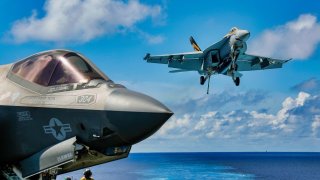Could Iran's Missiles Sink a U.S. Navy Aircraft Carrier?
Iran has spent considerable time and effort building missiles that could attack U.S. aircraft carriers if a war ever broke out.
The United States Central Command (CENTCOM) confirmed on Monday evening that the Norwegian-owned tanker Strinda came under attack in the Red Sea, sixty nautical miles to the north of Bab el-Mandeb. The vessel was hit by a cruise missile launched from Yemen.
"At around 4 p.m. EST on December 11, the Motor Tanker STRINDA was attacked by what is assessed to have been an Anti-Ship Cruise Missile (ASCM) launched from a Houthi-controlled area of Yemen while passing through the Bab-el-Mandeb. The STRINDA reported damage causing a fire on board, but no casualties at this time. There were no US ships in the vicinity at the time of the attack, but the USS MASON responded to the M/T STRINDA's mayday call and is currently rendering assistance," CENTCOM posted on X, the social media platform formerly known as Twitter.
The attack on the Strinda came after ballistic missiles fired by Yemen's Houthi rebels struck three commercial ships earlier this month in the Red Sea, while the U.S. Navy Arleigh Burke-class guided-missile destroyer USS Carney (DDG-64) also came under fire.
The USS Carney has shot down more than 22 missiles and drones launched by the Houthi rebels since she was deployed to the Middle Eastern waters in October. The Navy released a video last week that included footage of the warship downing the missiles, and it ended with the caption "22-0."
Washington has also vowed to "consider all appropriate responses" in the wake of these attacks, specifically calling out Iran, the Associated Press reported.
Are The U.S. Navy's Carriers at Risk from Iran's Missiles?
The audacity of the Houthis has raised the question of whether it or perhaps even Iran, might try to strike an even more inviting target – namely a U.S. aircraft carrier.
Since last month, the Nimitz-class nuclear-powered supercarrier USS Dwight D. Eisenhower (CVN-69) and her strike group (IKECSG) have been operating in the Gulf of Oman, as part of Washington's efforts to deter any escalation in the ongoing conflict between Israel and Hamas in Gaza. In addition, the USS Gerald R. Ford (CVN-78) has been operating in the Mediterranean, with her deployment to the region extended.
It was late in November that an Iranian drone was reported to have made an unsafe flight, and ignored multiple warnings, USNI News reported. At one point, the unmanned aerial vehicle (UAV) even came within 1,500 yards of the carrier.
A small drone presents a threat to a warship, but there are now concerns that Iran – or its proxies – might try to strike a U.S. carrier with a long-range anti-ship cruise missile such as the Islamic Republic's Noor, which was reverse-engineered from the Chinese C-802 anti-ship missile.
The sea-skimming missile was first provided to Tehran in 1995, but Beijing's export was canceled after U.S. pressure. However, the Islamic Republic was able to reverse engineer it successfully. The Noor reportedly employs millimeter-wave active radar in the final stage of its flight to find the target and home in the missile on it – while it is also believed to be very hard to jam. It has a range of up to 220 km (136 miles), and has a maximum speed of Mach 1.4 during its terminal stage.
The Abu Mahdi Long-Range Anti-Ship Missile
An even greater concern for the U.S. Navy and merchant vessels is the Abu Mahdi long-range anti-ship missile, which entered service with the Islamic Republic of Iran Navy (IRIN) and the Islamic Revolution Guard Corps Navy (IRGCN) this past summer.
Named after an Iraqi militia commander who was killed with the IRGC's Major General Qasem Soleimani in a January 2020 U.S. airstrike, the Abu Mahdi was unveiled in August 2020 and has a claimed range of more than 1,000 km (620 miles), Janes reported.
Iranian Rear Admiral Alireza Tangsiri, the commander of the IRGCN, said during the July ceremony in which the missiles were revealed, "One of the things that this missile can do is to repel the enemy, and it can drive the enemy away from our coasts."
Tangsiri suggested that the missiles would force the U.S. Navy's aircraft carriers to withdraw so far that aircraft couldn't reach Iran.
According to a report from the Tasnim News Agency, the dual-radar seeker has both active and passive modes and the missile's guidance system employs artificial intelligence (AI) to plot a flightpath via a series of waypoints, enabling it to exploit gaps in enemy air-defense coverage and enabling multiple missiles to simultaneously approach a target from different directions.
Tehran has further claimed that its recently unveiled Khyber ballistic missile has a range of 2,000 km (1240 miles) and can carry a warhead weighing 1,500 kg.
However, as The Jerusalem Post noted, Tehran often boasts about new systems and makes all sorts of claims that are hard to verify.
Still, the U.S. Navy has seen its warships come under repeated attacks. USS Carney may be 22-0 but a single loss could be devastating for the vessel. The same would be true of a carrier.
An enemy only needs to get lucky once! And Iran may be building a lot of missiles to help its odds.
Author Experience and Expertise
Peter Suciu is a Michigan-based writer. He has contributed to more than four dozen magazines, newspapers, and websites with over 3,200 published pieces over a twenty-year career in journalism. He regularly writes about military hardware, firearms history, cybersecurity, politics, and international affairs. Peter is also a Contributing Writer for Forbes and Clearance Jobs. You can follow him on Twitter: @PeterSuciu.


